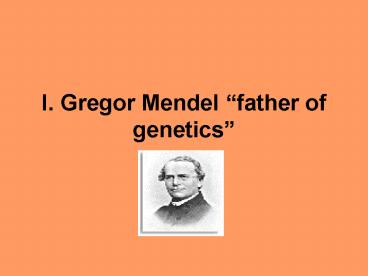I' Gregor Mendel father of genetics - PowerPoint PPT Presentation
1 / 24
Title:
I' Gregor Mendel father of genetics
Description:
The standard way of labeling the variation information of a trait in a ... The letter being used describes a variation (usually the recessive) of the trait. ... – PowerPoint PPT presentation
Number of Views:113
Avg rating:3.0/5.0
Title: I' Gregor Mendel father of genetics
1
I. Gregor Mendel father of genetics
2
a. Inheritance Theory Prior to Mendel
- 1. Traits blended
- Trait characteristics to be passed from parent
to offspring - bloodlines thought traits passed through the
blood - 2. Problem with blending cannot account for
unexpected traits
3
II. Mendel- the story
- Personal history
- 1. Austrian monk
- 2. Teacher of high school natural science- love
of evolution, nature, meteorology - 3. for the fun of it crossed peas and mice-
saw inheritance patterns - 4. pea plants- a formal test
4
- 5. lets add math
- - importance of statistics and ratios basis
for his hypotheses - - problem the math created not used in
biology previously - b. The research
- 1. pea plants- why?
- - structure (male and female parts on same
plant) - - distinctive traits
- - rapid reproduction
- - ability to control pollination and
fertilzation
5
Steps of Mendel's Experiment
6
1. Mendel studied the inheritance of one trait
(for example plant's height, color of flowers
or color and shape of seeds).
7
2. Mendel first cross pollinated tall pea
plants (identified as TT, height of plants
in this variety were about six feet
tall) with each other.
8
(No Transcript)
9
Mendel noticed, that only tall plants were
produced. He came to a conclusion, that the
tall variety of a pea plant, must contain some
factor for tallness.
10
3. Mendel then cross pollinated short pea
plants (identified as tt, height of plants in
this variety were about one foot tall) with
each other.
11
X
12
In every generation of this plant only short
plants were produced. Once again he concluded
that pea plant must contain some factor for
height (in that variety - for shortness).
13
4. The next step of Mendel's experiment was to
crossed tall pea plants (TT) with short pea
plants (tt). The resulting plants were labeled
Tt and only tall plants were produced.
14
(No Transcript)
15
All plants were tall
16
Labeling
- The standard way of labeling the variation
information of a trait in a particular organism
is using two letters. Capital letters represent
information which is dominant. Lowercase letters
represent the recessive. The letter being used
describes a variation (usually the recessive) of
the trait. - TT stands for a plant where both pieces of height
information are dominant - tall. The plant is
tall.Tt stands for a plant where one piece of
height information is dominant - tall, and the
other is recessive - short. The plant is
tall.Tt stands for a plant where one piece of
height information is recessive - short, and the
other is dominant - tall. The plant is tall.tt
stands for a plant where both pieces of height
information are recessive - short. The plant is
short.
17
Here we crossed two peas which contained both
tall and short information.
18
(No Transcript)
19
A cross in which only one trait is studied is
called monohybrid cross .
20
5. Mendel named every generation Starting
generation P (parent) generation. The
following offspring generation was called
F1 - first generation (daughter generation),
F2 - second filial generation, and so on.
21
P
F1
F2
22
- 2. results from experiments
- - tall x short ----- gt all tall
- - dominant ---- gt tall
- - recessive ---- gt short
- - hybrid x hybrid ---- gt result of crossing F1
generation- led to the idea of gene forms - 3. the gene
- - sections of chromosomes coding for a trait
- - alleles forms of a gene (ex tall and short
for the gene for height)
23
- 4. no blending Mendel found that blending was
not occurring since all traits expressed were
either dominant or recessive, but not in between
(ex either tall or short not medium) - 5. example crosses
- AA x AA aa x aa
- Aa x Aa
24
- c. Research rejected
- 1. why?
- - math not previously used in science
- - public skeptical
- - information not understood
- - public distracted by Charles Darwins study on
evolution - d. Importance of research
- - evolution provided genetic support for this
theory - - modern genetics studies we still use much of
Mendels conclusions in our own theories/ studies
in genetics































